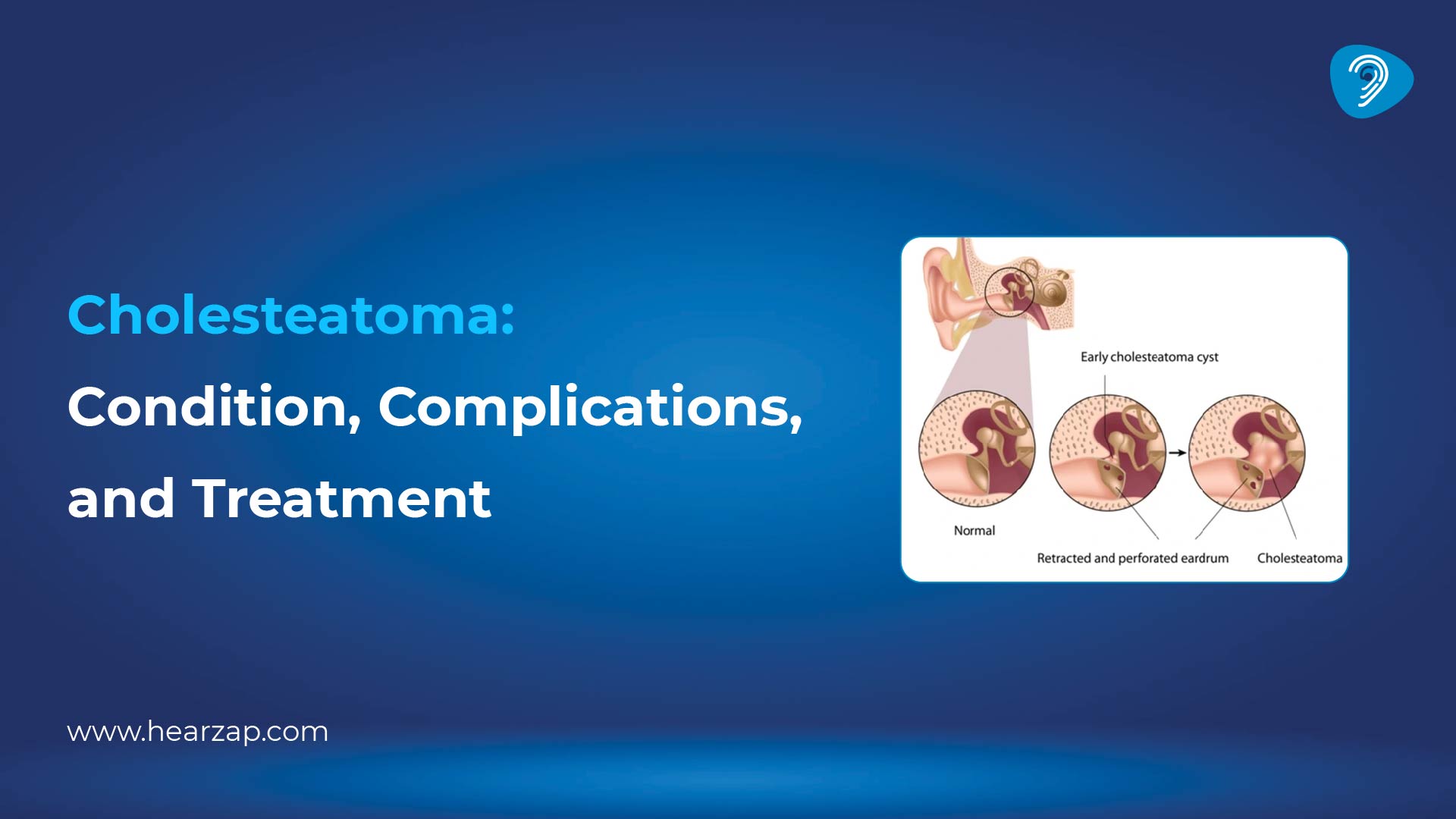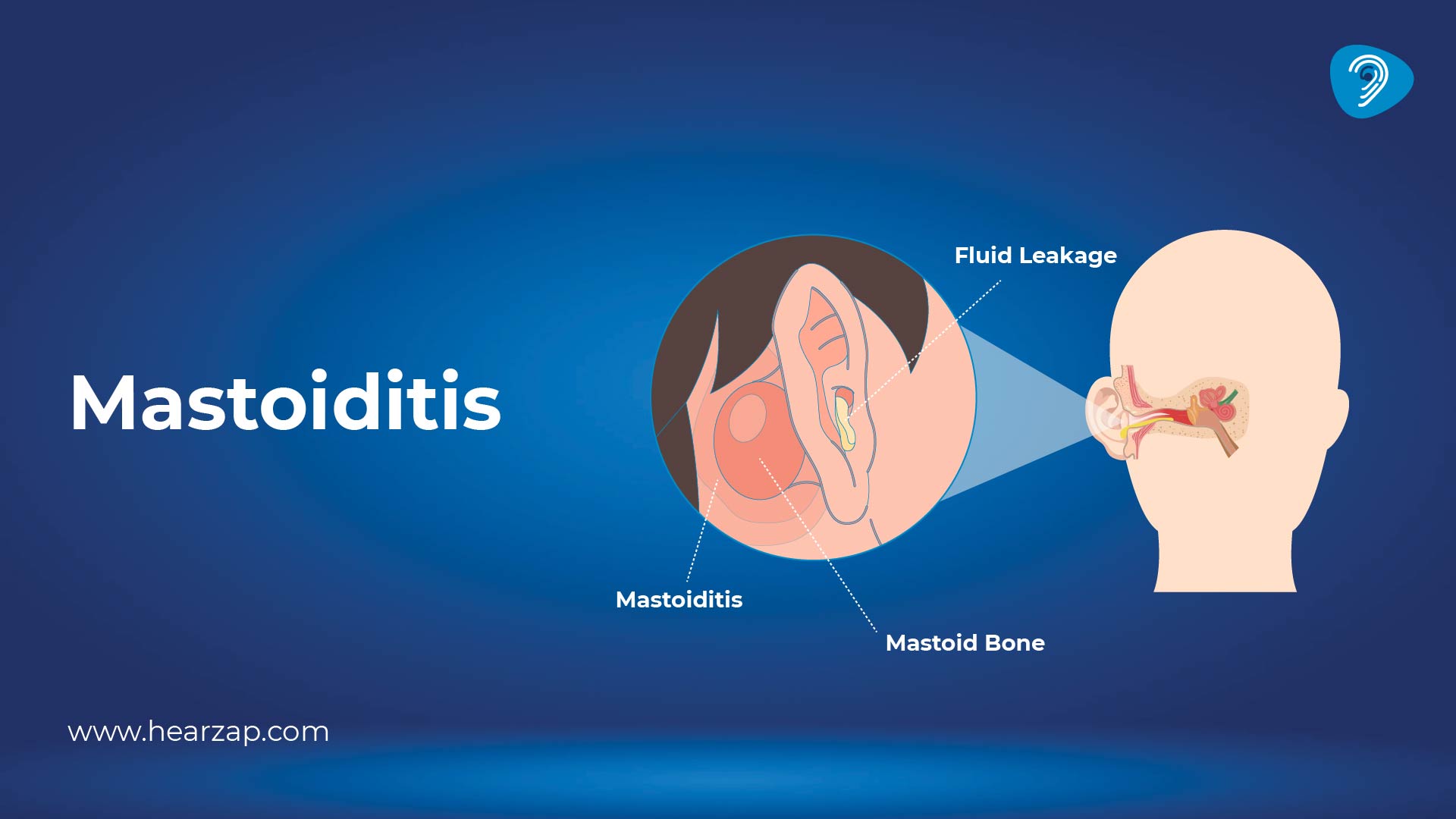Generic
Cholesteatoma: Understanding the Condition, Complications, and Modern Treatment
By Team Hearzap | Nov. 18, 2025

Cholesteatoma is a condition that often begins quietly, yet has the potential to cause serious damage inside the ear if left untreated. People usually notice symptoms like persistent discharge, hearing loss, or a sense of fullness in the ear, but don’t always realise that something more complex may be happening beneath the surface. For clinicians, identifying and managing this condition early is critical because it can gradually affect hearing, balance, and even nearby structures of the skull.
This guide provides an easy to follow and reliable description of cholesteatoma, its development, and the usual treatment.
What Is a Cholesteatoma?
A cholesteatoma is an abnormal growth of skin cells inside the middle ear. Although the name sounds like a tumour, it is not cancer. Instead, it is a collection of trapped skin that slowly expands over time. The most accurate way to understand the condition begins with the cholesteatoma meaning, which refers to a destructive cyst-like pocket of skin that forms where it doesn’t belong.
From a medical point of view, the cholesteatoma definition describes it as a keratinising lesion that can erode bone and disrupt the delicate structures that allow hearing and balance. This is why early diagnosis plays such an important role in preventing long-term complications.
How Cholesteatoma Forms
A cholesteatoma ear may develop for many reasons. The most common cause is repeated ear infections. When the eustachian tube — the small channel that equalises pressure — stops functioning properly, the eardrum can retract inward. This retracted pocket traps skin cells that accumulate and form the cholesteatoma.
Cholesteatomas may be congenital. In these cases, a small bit of skin becomes trapped inside the ear during development before birth. Although rare, congenital cases can still cause damage if they are not detected early.
Regardless of how it begins, the growth expands slowly but steadily. As it does, it can erode the ossicles (hearing bones), the mastoid bone, or even the bony covering of the facial nerve or inner ear. This explains why symptoms may start small but become more noticeable over time.
Symptoms to Watch Out For
Cholesteatoma has a typical symptom pattern, which is usually slow to develop:
- Ear discharge that is either persistent or recurring, with the latter often being the case, and frequently accompanied by an unpleasant odor
- Hearing impairment that gradually increases and gets worse with time
- A sensation of pressure or fullness in the ear
- Pain that occurs occasionally
- In some instances, dizziness or an unsteady feeling
- Tinnitus (ringing in the ears)
The presence of all these symptoms is not necessary for the diagnosis of cholesteatoma; however, the two symptoms of ongoing discharge and hearing loss are usually the most evidence of the disease.
Why Early Diagnosis Matters
Even though cholesteatoma grows slowly, the damage it causes can be significant. As the mass expands, it can erode bones, interfere with the middle ear's function, and, in rare cases, affect structures near the brain. An early diagnosis will be a key component of present-day treatment for cholesteatoma, as it would help prevent complications and save a good amount of hearing capacity.
Specialist physicians, like ear, nose, and throat (ENT) specialists, looking through a microscope may see the cystic structure. Sometimes, a CT scan may determine the extent of the disease. These steps help create a clear picture of the condition so the appropriate treatment plan can be made.
Treatment Options
There is one important truth about cholesteatoma: it does not disappear on its own. Medical therapy can reduce infection or inflammation, but the underlying growth must be removed. For this reason, cholesteatoma surgery is the main treatment for most patients.
Surgery is performed to remove the entire cyst and prevent regrowth. The approach depends on the size and location of the cholesteatoma, as well as the condition of the middle ear bones. Some surgeries are completed in one stage, while others require a second procedure months later to confirm that the ear has healed properly.
After removal, the hearing mechanism may be reconstructed if the ossicles have been damaged. In these situations, restoring hearing becomes part of the broader cholesteatoma treatment plan.
Recovery and Long-Term Care
The healing process is different for each patient and depends on the stage of the disease and the surgical procedure used. Generally, patients are discharged on the same day or the day after surgery. Follow-up appointments are very important since cholesteatomas can sometimes grow back. Checking the patient regularly makes sure that any new growth is detected at an early stage.
In the case of a lot of patients, their hearing gets better after surgery, particularly in situations where the ossicles are left intact. In such cases, hearing restoration may require further reconstruction. Surgeons frequently talk about these options prior to the operation so the patients will be well-informed about the process.
Possible Complications if Left Untreated
Cholesteatoma, though not fatal, can still lead to dire consequences if neglected. The following are some of the potential effects of unchecked growth:
- Hearing loss that cannot be treated
- Infections that keep reoccurring
- The facial nerve may be harmed
- Problems with balancing due to the inner ear being affected
- Very rare but severe complications that can involve the brain
The aforementioned risks clearly demonstrate the necessity of an early diagnosis and treatment.
Living with and Managing Cholesteatoma
Although cholesteatoma can feel intimidating, most people do very well with proper evaluation and timely surgery. Understanding the cholesteatoma meaning helps patients realise that it is a manageable condition. Likewise, knowing the correct cholesteatoma definition empowers them to make informed decisions about treatment.
Due to recent advancements in surgical techniques, a skilled surgeon can safely remove a cholesteatoma in the ear while also preserving the surrounding structures. If long-term check-ups succeed cholesteatoma surgery, the prognosis should be very good.
FAQs
What is cholesteatoma?
It’s an abnormal skin growth in the middle ear that can slowly damage nearby structures if left untreated.
Can you die from cholesteatoma surgery?
The surgery is generally very safe, and serious complications are extremely rare with modern medical care.
Is cholesteatoma hereditary?
Most cases are not hereditary, though a few rare congenital forms can occur at birth.
Can a cholesteatoma come back?
Yes, it can recur, which is why follow-up check-ups after treatment are important.
Can cholesteatoma be cured?
Indeed, it is curable through proper surgical cleave and then be kept under close observation at regular intervals.
Contact us
We are here for all your hearing needs, from hearing tests to hearing aids. Fill out the form below, and we will give you a call soon.
Please enter a valid mobile number with 10 digits.
Recent Blogs
By None | Nov. 17, 2025
By Team Hearzap | Nov. 5, 2025
By None | Nov. 4, 2025
By None | Nov. 3, 2025
By Team Hearzap | Nov. 1, 2025












